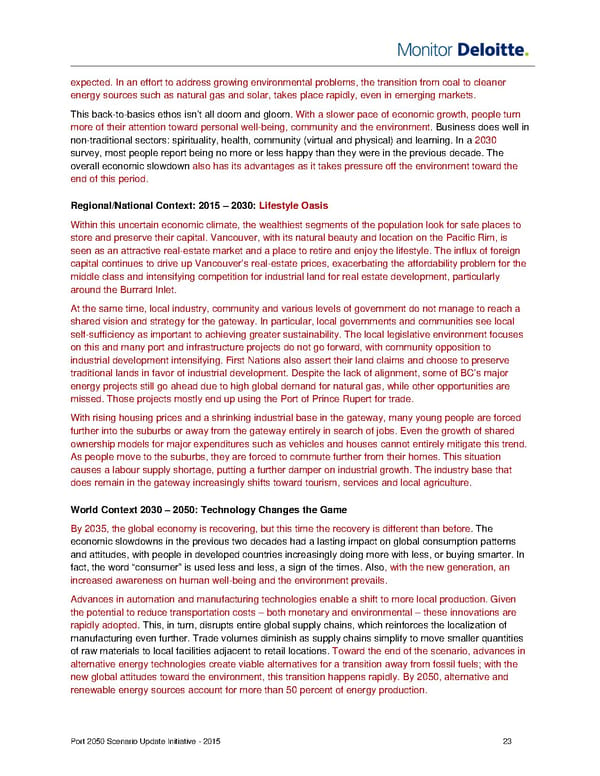expected. In an effort to address growing environmental problems, the transition from coal to cleaner energy sources such as natural gas and solar, takes place rapidly, even in emerging markets. This back-to-basics ethos isn’t all doom and gloom. With a slower pace of economic growth, people turn more of their attention toward personal well-being, community and the environment. Business does well in non-traditional sectors: spirituality, health, community (virtual and physical) and learning. In a 2030 survey, most people report being no more or less happy than they were in the previous decade. The overall economic slowdown also has its advantages as it takes pressure off the environment toward the end of this period. Regional/National Context: 2015 – 2030: Lifestyle Oasis Within this uncertain economic climate, the wealthiest segments of the population look for safe places to store and preserve their capital. Vancouver, with its natural beauty and location on the Pacific Rim, is seen as an attractive real-estate market and a place to retire and enjoy the lifestyle. The influx of foreign capital continues to drive up Vancouver’s real-estate prices, exacerbating the affordability problem for the middle class and intensifying competition for industrial land for real estate development, particularly around the Burrard Inlet. At the same time, local industry, community and various levels of government do not manage to reach a shared vision and strategy for the gateway. In particular, local governments and communities see local self-sufficiency as important to achieving greater sustainability. The local legislative environment focuses on this and many port and infrastructure projects do not go forward, with community opposition to industrial development intensifying. First Nations also assert their land claims and choose to preserve traditional lands in favor of industrial development. Despite the lack of alignment, some of BC’s major energy projects still go ahead due to high global demand for natural gas, while other opportunities are missed. Those projects mostly end up using the Port of Prince Rupert for trade. With rising housing prices and a shrinking industrial base in the gateway, many young people are forced further into the suburbs or away from the gateway entirely in search of jobs. Even the growth of shared ownership models for major expenditures such as vehicles and houses cannot entirely mitigate this trend. As people move to the suburbs, they are forced to commute further from their homes. This situation causes a labour supply shortage, putting a further damper on industrial growth. The industry base that does remain in the gateway increasingly shifts toward tourism, services and local agriculture. World Context 2030 – 2050: Technology Changes the Game By 2035, the global economy is recovering, but this time the recovery is different than before. The economic slowdowns in the previous two decades had a lasting impact on global consumption patterns and attitudes, with people in developed countries increasingly doing more with less, or buying smarter. In fact, the word “consumer” is used less and less, a sign of the times. Also, with the new generation, an increased awareness on human well-being and the environment prevails. Advances in automation and manufacturing technologies enable a shift to more local production. Given the potential to reduce transportation costs – both monetary and environmental – these innovations are rapidly adopted. This, in turn, disrupts entire global supply chains, which reinforces the localization of manufacturing even further. Trade volumes diminish as supply chains simplify to move smaller quantities of raw materials to local facilities adjacent to retail locations. Toward the end of the scenario, advances in alternative energy technologies create viable alternatives for a transition away from fossil fuels; with the new global attitudes toward the environment, this transition happens rapidly. By 2050, alternative and renewable energy sources account for more than 50 percent of energy production. Port 2050 Scenario Update Initiative - 2015 23
 Monitor Deloitte - Final Report Page 24 Page 26
Monitor Deloitte - Final Report Page 24 Page 26